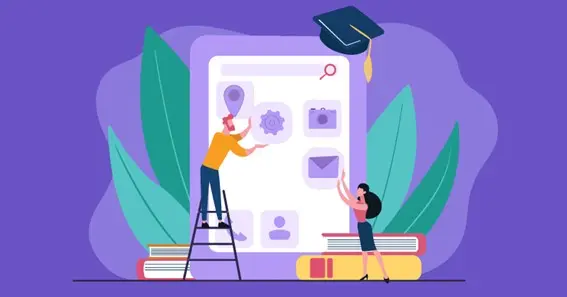To streamline a digitized learning environment, a learning management system (LMS) is required. It facilitates digital learning optimization for educational institutions of all types. Teachers find it easy to manage, administer, and evaluate learning results. Moreover, it automates various manual tasks, unifies different learning cohorts, facilitates learning outcomes, and makes learning fun with its gamification tools.
Your institute can benefit from enhanced digital learning services for students and staff by implementing a learning management system (LMS). So, we have listed below the top seven LMS software for educational institutes in 2023. Now, let’s dive into the specifics of each LMS software.
Schoology LMS
Schoology LMS is an effective LMS software for K-12 to higher education. It standardizes course content, facilitates classroom instruction, promotes collaborative learning, and facilitates the pooling of educational resources. It integrates assessment and learning management to boost academic performance, increase teamwork, and individualize instruction. In addition, it integrates smoothly with the tools of other programs, expanding its flexibility.
Pros
- Tools can help educators plan and execute effective lessons, evaluate student growth, and develop expertise.
- Courses, assignments, assessments, and student progress may all be readily added, revised, and monitored by educators.
- The interface is simple and straightforward, much like a social media platform.
Cons
- It occasionally experiences slowdowns.
Pricing
You need to contact a vendor directly for accurate pricing information for the Schoology LMS.
Also Read N: Clearing Out Clutter: Steps To Create Space On Your Mac
Blackboard Learn
From course authoring to online classes and reporting, Blackboard Learn is another viable option. It integrates gamification services to amplify the learning experience. Course completion tasks and material suggestions are beneficial for tracking outcomes and interest-based recommendations. It has vast personalization capabilities, ranging from color scheming to layout designing. Moreover, it also provides collaboration tools that maximize the learning experience with individual communication or peer-to-peer learning. Instructors and learners can easily set up their classes and cohorts.
Pros
- Its user interface is notably customizable, making it a versatile choice.
- Different tools, like quizzes and tests, provide an experience near physical classes.
- Instructors can edit, create, and share content courses with its all-in-one services.
Cons
- The first-time familiarity with Blackboard Learn might take a little longer.
Pricing
Blackboard Learn cost is not public; contact a vendor for its quote.
Also Read P: What Is Barracks Bunny? Does It Really Exist?
Schoox
For an institution, Schoox is an LMS that excels at providing high-end learning services. It can be used to create e-learning courses, and publish, and regulate them. Included are tools for creating and managing content in a variety of configurations, as well as for tracking and analyzing user activity in real time. In addition, it provides multimedia resources like slideshows, quizzes, and interactive modules for learning. It provides tools for instructor-led sessions or group meetings to facilitate virtual interactions. Course enrollment, progress, evaluations, and course completion are just some user outcomes that can be reported.
Pros
- There is not much of a learning curve in Schoox.
- Schoox streamlines distance learning and online/offline combinations.
- Other than educational institutes, learning environments can be beneficial for any business to implement L&D services.
Cons
- Gamification and a few tools are not compatible.
Pricing
Only vendors can provide their quotes on request.
TOPYX
TOPYX also simplifies and improves the efficacy of education institutions as learning environments. Facilitation of instructional planning, management, assessment, gaming, and teamwork is available. It also works well on smartphones and tablets. Everyone who will be using it receives free introductory instruction. TOPYX also provides a variety of webinar and online class session tools since it places a premium on collaborative learning. Take note that its outcome stats are always viewable by admins. Learners could be evaluated with the use of reports and the monitoring of results.
Pros
- The API and subsequent program compatibility are frequently cited as its key benefits.
- You can pick from more than fifty varied report modules for analytical and assessment.
- The available documentation of a certain program might guide initial training.
Cons
- The navigation control needs to be improved.
Pricing
Its annual subscription begins at $6850. However, it offers four editions.
Brightspace
Brightspace is another comprehensive platform for digital training and education. Its dynamic tools help educators create interactive classrooms to engage students better. Virtual instruction, conferences, reviews, and monitoring of student progress are all simple to implement. It’s simple to set up and works with various programs and tools. Adaptability to different skill sets and knowledge bases is another benefit of customization. Companies, secondary schools, and colleges can all benefit from using Brightspace. Moreover, it incorporates an ePortfolio, a learning repository, and a learning environment.
Pros
- It handles all the learning administrative details, from reporting to evaluation.
- Brightspace offers API accessibility.
- Its high-end customization provides an excellent educational experience.
Cons
- It sometimes causes downtime, and the system freezes.
Pricing
Only vendors can provide pricing information.
Skolaro
Skolaro bridges the gaps in distance learning for K-12 institutions and higher education institutions. Its integrated learning management system (LMS) and other features are fully configurable. It also helps with tools for managing library catalogs, fee payments, and reporting. Furthermore, it simplifies documentation for both educators and administrators. To sum it up, Skolaro complies with the varying needs of different programs, instructors, and learners.
Pros
- Integrating Skolaro with your current LMS is quick and simple.
- You get everything you need, including HR management, roll-over administration, and so on.
- Skolaro has a straightforward UI that makes it easy to get started.
Cons
- There are no asynchronous learning resources available.
Pricing
The price can be acquired only from a vendor.
Pocket Study
Pocket Study is designed to assist instructors, schools, and students in online learning and teaching better and faster. It provides everything educators need to manage their virtual classrooms and course materials. Interacting with students, monitoring their development, and building relationships is simple. Secure connectivity between Pocket Study and other services like payment processors, media players, and audio podcasts improve the user experience and make studying more engaging.
Pros
- Educators can use its built-in functionality to record audio and add images to flashcards.
- Its user interface is intuitive and has valuable features for students and teachers.
- The ability to categorize and classify subjects and lessons is a huge time saver for students.
Cons
- Pocket Study must incorporate more diverse learning templates.
Pricing
Its prices are not made public and must be requested directly from a vendor.
Why Do You Need LMS Software?
Students’ attention is one of the most pivotal aspects of sustaining a meaningful learning environment. Digital learning is not just a connection between screens. If you’re not keeping tabs on learners’ outcomes and don’t provide a streamlined learning experience, they might lose their interest. However, LMS software has attained 60% learning retention compared to traditional online learning.
Moreover, LMS software also provides flexibility to instructors and learners alike. Instructors can keep adding material, make changes, notify learners automatically, and evaluate performance systematically. As for learners, they can reach out to material based on their availability, pause a course, and resume where they left off. Above all, unlike rigorous traditional online tools, you can personalize LMS software according to your learning setting.
Conclusion
LMS software is important for streamlining the digital learning experience. Content creation, formatting, learning assessments, and tasks are incorporated into LMS software. Moreover, its inclusive digital learning involves peer learning and communication channels. All in all, educational institutions can administer and amplify digitized learning. However, there are approximately 800 LMS programs. So, we have reviewed the top seven LMS software of 2023. Pick the most suitable option.






